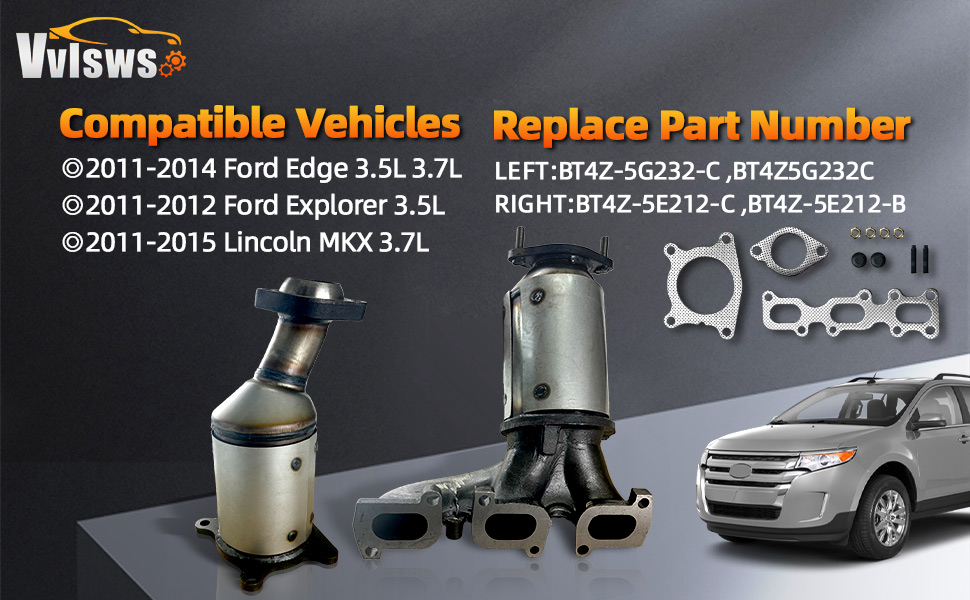2014 Ford Explorer Xlt Catalytic Converter

The 2014 Ford Explorer XLT, a popular choice for families and adventurers alike, relies on a crucial component to meet emissions standards: the catalytic converter. This unassuming device plays a vital role in reducing harmful pollutants from the engine's exhaust. Let's delve into the specifics of the catalytic converter in the 2014 Explorer XLT, covering its function, potential issues, and maintenance considerations.
Understanding the Catalytic Converter
At its core, a catalytic converter is an emissions control device that uses chemical reactions to convert harmful gases into less harmful ones. In the 2014 Explorer XLT, which typically features a 3.5L V6 engine (though a 2.0L EcoBoost was also available), the converter is tasked with reducing hydrocarbons (HC), carbon monoxide (CO), and nitrogen oxides (NOx) – all byproducts of internal combustion. The converter achieves this using precious metals like platinum, palladium, and rhodium, which act as catalysts to speed up the chemical reactions. Think of it like a chemical processing plant, but nestled within your exhaust system.
Specifically, the 2014 Explorer XLT utilizes a three-way catalytic converter. "Three-way" refers to its ability to simultaneously reduce all three of the aforementioned pollutants. It relies on precise air-fuel mixture control, monitored by oxygen sensors both upstream and downstream of the converter, to function effectively. A malfunctioning oxygen sensor can dramatically impact the converter's efficiency and lifespan.
Common Issues and Symptoms
While catalytic converters are generally robust, they are not immune to failure. Several factors can lead to problems with the catalytic converter in a 2014 Explorer XLT. These include:
- Contamination: The most common culprit. Oil leaks, coolant leaks, or excessive fuel entering the exhaust system can coat the catalyst with contaminants, rendering it ineffective.
- Physical Damage: Impacts from road debris can physically damage the converter's core, reducing its surface area and efficiency.
- Overheating: Prolonged engine misfires or running rich (too much fuel) can cause the converter to overheat, leading to its premature degradation.
- Age: Like any component, the catalytic converter's effectiveness degrades over time.
The symptoms of a failing catalytic converter in a 2014 Explorer XLT often include:
- Check Engine Light: Often accompanied by diagnostic trouble codes (DTCs) related to catalytic converter efficiency, such as P0420 ("Catalyst System Efficiency Below Threshold").
- Reduced Engine Performance: A clogged converter can restrict exhaust flow, leading to decreased power and acceleration.
- Poor Fuel Economy: Inefficient combustion and restricted exhaust flow can contribute to a noticeable drop in MPG.
- Failed Emissions Test: A failing converter will likely result in a failed emissions test.
- Rattling Noise: If the internal substrate of the converter has broken apart, it may produce a rattling sound, especially when the engine is first started.
Diagnosis and Replacement
Diagnosing a catalytic converter issue requires a systematic approach. A mechanic will typically start by scanning the vehicle's computer for DTCs. They may then perform visual inspections of the converter for physical damage and use specialized tools to measure exhaust backpressure and converter efficiency. Oxygen sensor readings are also crucial in determining if the converter is functioning properly.
If the catalytic converter is confirmed to be faulty, replacement is usually the only viable solution. The cost of replacing the catalytic converter on a 2014 Ford Explorer XLT can vary significantly depending on the brand of converter used (OEM vs. aftermarket), the labor rates in your area, and whether any other related components (such as oxygen sensors) need to be replaced simultaneously. Expect to pay anywhere from $800 to $1500 for a complete replacement, including parts and labor. Choosing a high-quality converter from a reputable brand is essential for ensuring proper function and longevity.
Maintenance and Prevention
While a catalytic converter will eventually need replacement, preventative maintenance can extend its lifespan. Key steps include:
- Regular Engine Maintenance: Addressing issues like oil leaks, coolant leaks, and engine misfires promptly can prevent contaminants from damaging the converter.
- Proper Fuel System Maintenance: Keeping the fuel system clean and ensuring proper fuel pressure can prevent running rich conditions that can overheat the converter.
- Avoid Short Trips: Catalytic converters operate most efficiently when they reach operating temperature. Frequent short trips prevent them from reaching this optimal state.
- Use Quality Fuel: Avoid using low-quality fuel that may contain excessive amounts of additives that can harm the catalyst.
In conclusion, the catalytic converter is a vital component of the 2014 Ford Explorer XLT's emissions control system. Understanding its function, potential issues, and maintenance requirements can help owners keep their Explorers running smoothly and environmentally responsibly for years to come. Regularly inspecting the exhaust system and addressing any underlying engine issues promptly are crucial for maximizing the life of the catalytic converter and preventing costly repairs.
